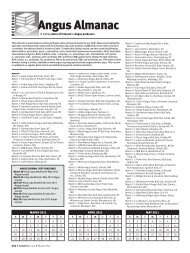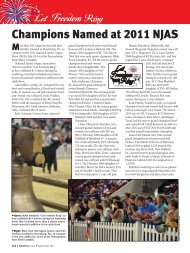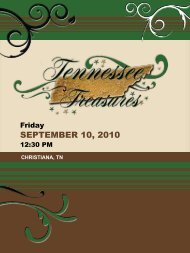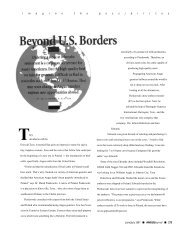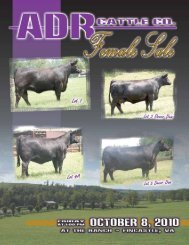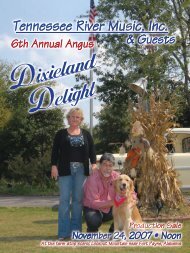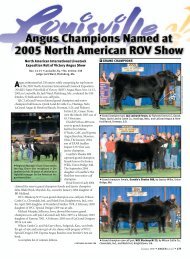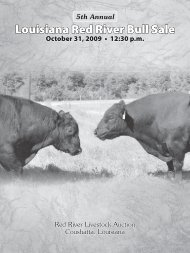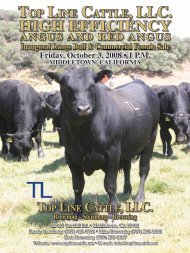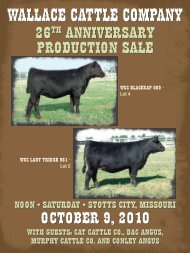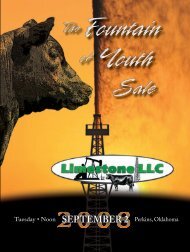mcwilliams ranches spring bull sale - Angus Journal
mcwilliams ranches spring bull sale - Angus Journal
mcwilliams ranches spring bull sale - Angus Journal
You also want an ePaper? Increase the reach of your titles
YUMPU automatically turns print PDFs into web optimized ePapers that Google loves.
MCWILLIAMS RANCHES SPRING BULL SALESale Book InformationAbout EPDs ...All available Expected Progeny Difference (EPD) numbers are included in the<strong>sale</strong> book and were current as of 02/17/2006, as reported by the American<strong>Angus</strong> Association.EPDs are predictions of how future progeny are expected to perform in each ofthe traits listed. Interim EPD is indicated by an “I” to the left of the minus orplus sign preceding the EPD. Interim EPDs are calculated on animals on whichAHIR records have been processed between National Cattle Evaluationsconducted twice per year. Interim EPDs are updated in the next National CattleEvaluation, provided all edit checks are met.PRODUCTION EPDS:Birth Weight (BW), expressed in pounds, is a predictor of a sire’s ability totransmit birth weight to his progeny, compared to the progeny of an average<strong>Angus</strong> <strong>bull</strong>.Weaning Weight Direct (WW), expressed in pounds, is a predictor of a sire’sability to transmit weaning growth to his progeny, compared to the progeny ofan average <strong>bull</strong> in the <strong>Angus</strong> breed.Yearling Weight (YW), expressed in pounds, is a predictor of a sire’s ability totransmit yearling weight compared to the progeny of an average sire in the<strong>Angus</strong> breed.Weaning Weight Maternal (Milk), is a predictor of a sire’s genetic merit formilk and mothering ability as expressed in his daughters. In other words, it isthat part of weaning weight attributed to milk and mothering ability. It iscompared to daughters of an average <strong>bull</strong> in the <strong>Angus</strong> breed.CARCASS EPDS:EPDs for carcass traits are provided for sons of sires/dams that have had steersand heifers harvested through structured sire evaluation.Carcass Weight EPD (CWT), expressed in pounds, is a predictor of thedifferences in hot carcass weight of a sire’s progeny at a given end point,compared to the progeny of an average sire in the <strong>Angus</strong> breed.Marbling (Marb), expressed in a fraction, is the differences in a subjectiveUSDA marbling score of a sire’s progeny at a given end point, compared to theprogeny of an average sire in the <strong>Angus</strong> breed.Rib Eye Area (RE), expressed in square inches, is a predictor of the difference inrib eye area of a sire’s progeny at a given end point, compared to the progeny ofan average sire in the <strong>Angus</strong> breed.Fat Thickness (FAT), expressed in inches, is a predictor of the differences in fatthickness of a sire’s progeny, between the 12th and 13th ribs, at a given endpoint, compared to the progeny of an average sire in the <strong>Angus</strong> breed.ULTRASOUND EPDS:Derived from real time ultrasound scanning measurements processed throughCentralized Ultrasound Processing (CUP).Intramuscular Fat (UIMF), is a predictor of the difference in a sire’s progenyfor percent intramuscular fat in the rib eye muscle compared to an average sirein the <strong>Angus</strong> breed.Rib Eye Area (URE), is a predictor of the differences in square inches of rib eyearea of a sire’s progeny, compared to an average sire in the <strong>Angus</strong> breed.Fat (UFat), expressed in inches, is a predictor of the differences in ultrasound fatthickness at the 12th rib of a sire’s progeny compared to the progeny of othersires. It includes the weighted average of 60% of the rib fat measurement and40% of the rump fat measurement.Breed Average EPDs and $Values for Non-Parent<strong>Angus</strong> Bulls:BW WW YW MILK $W $F $G $B+2.2 +42 +77 +20 +24.22 +20.56 +15.79 +34.20UIMF URE UFat+.16 +.27 +.006Remember: EPDs and $Values are more reliablefor a group of <strong>bull</strong>s than for an indvidual <strong>bull</strong>.$Value IndexesWHAT ARE THEY?$Values are multi-trait selection indexes, expressed in dollars per head, to assistbeef producers by adding simplicity to genetic selection decisions. A $Value is anestimate of how future progeny of each sire are expected to perform, on average,compared to progeny of other sires in the database if the sires were randomlymated to cows and if calves were exposed to the same environment.WEANED CALF VALUE ($W)Expressed in dollars per head, the expected average difference in future progenyperformance for preweaning merit. Includes both revenue and cost adjustmentsassociated with differences in birth weight, weaning weight, milk and maturecow size.FEEDLOT VALUE ($F)Expressed in dollars per head, is the expected average difference in futureprogeny performance for postweaning performance compared to progeny ofother sires. Calculated for animals with growth traits EPDs.GRID VALUE ($G)Expressed in dollars per head, the expected average difference in future progenyperformance for carcass grid merit compared to progeny of other sires.Combines quality grade and yield grade attributes and is calculated for animalswith carcass EPDs, ultrasound EPDs or both types of EPDs.BEEF VALUE ($B)Expressed in dollars per head, the expected average difference in future progenyperformance for postweaning and carcass value compared to progeny of othersires. The $B value combines the contributions of $F and $G to facilitate whatmost beef breeders are seeking — simultaneous multi-trait genetic improvementfor feedlot and carcass merit, based on dollars and cents.$Values have meaning when used in comparing the relative merit or ranking oftwo individuals. For example, Bull X has a$B value of +26.00, and Bull Y has a$B value of +16.00. If these <strong>bull</strong>s were randomly mated to comparable femalesand the calves were exposed to the same environment, per head advantage inpostweaning performance and carcass merit over Bull Y’s progeny (26.00 - 16.00= +10.00 per head).The $B value is not designed to be driven by one factor such as quality, redmeat yield or weight. Instead, it is a result of the application of industryrelevantmarket values to <strong>Angus</strong> genetics for both feedlot performance andcarcass merit.HOW CAN YOU USE $VALUE INDEXES?$Values should be used to complement the criteria that producers already usewhen selecting <strong>bull</strong>s. Different management situations may require varyingemphasis on the genetic selection tools offered. The $Values are not designed tobe driven by a single trait, as an index is multi-trait by design. These selectiontools are the result of the application of industry-relevant market values to <strong>Angus</strong>genetics for preweaning, feedlot and carcass merit. Economic studies have shownthat fertility and reproductive value are the primary determinant of profitabilityin a cow herd. Performance and growth are next, followed by carcasscharacteristics.The $W, $F, $G and $B values on individual animals and the current SireEvaluation Report may be viewed at www.angus.org. Questions on $Values canbe directed to: American <strong>Angus</strong> Association Performance Programs Department,3201 Frederick Ave., St. Joseph, MO 64506. Phone (816) 383-5100.ahir@angus.orgOTHER SALE BOOK ABBREVIATIONS:Pathfinder animals are indicated by the pound (#) sign preceding thename/registration number.Embryo transplants are indicated by the plus (+) sign preceding thename/registration number.BW: Actual birth weight.WW: Weaning weight, adjusted to 206-days of age.YW: Yearling weight, adjusted to 365-days of age.Ultrasound measurements adjusted to 365-days of age.23 | Thursday, April 3, 2008 • 12:30 p.m. • at the ranch 12 miles west of Muskogee, OK




